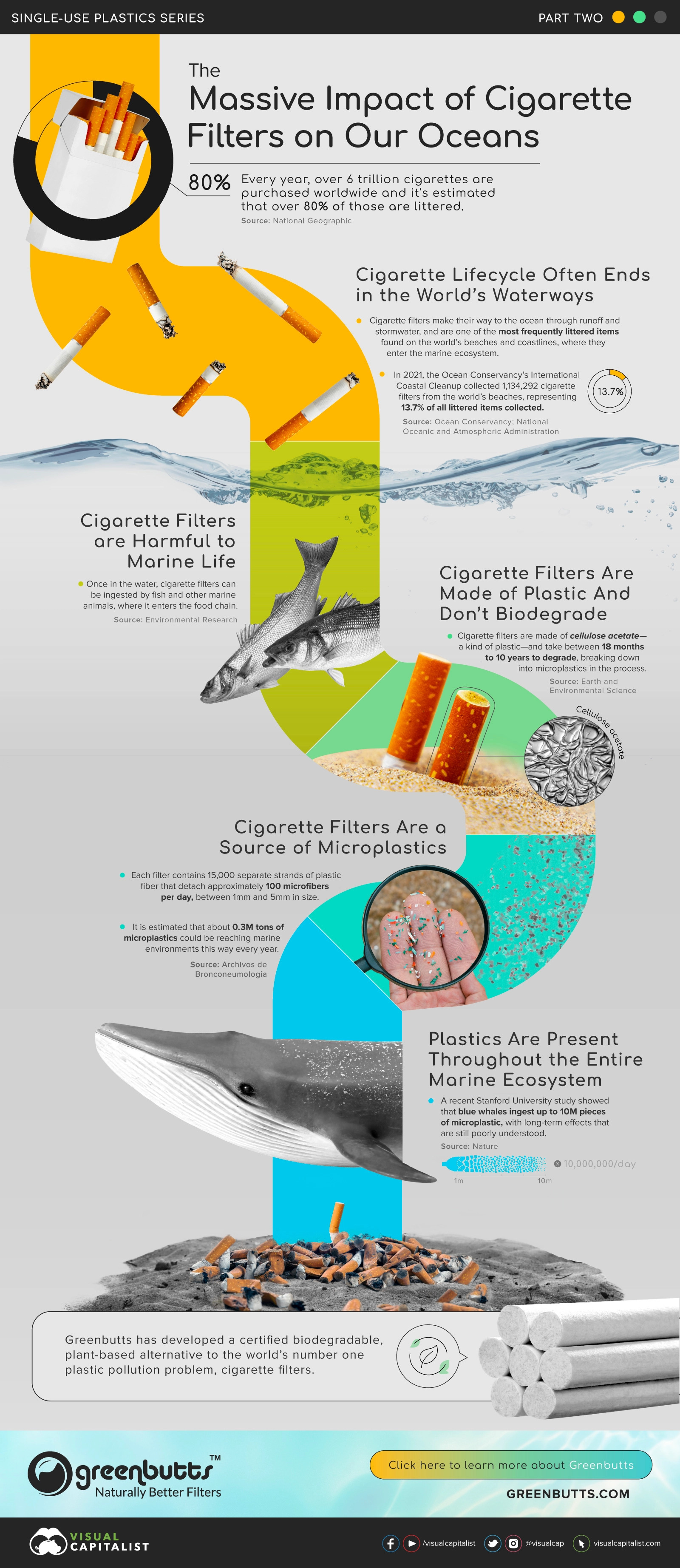
Massive Impact of Cigarette Filters on Our Oceans

The Massive Impact of Cigarette Filters on Our Oceans
Around 80% of the 6 trillion cigarettes purchased annually are littered, and many of those end up in oceans, adding to the global plastic problem.
Cigarette filters make their way to the world’s oceans through floods, runoff, and stormwater where they cause significant harm.
In this visualization, the second in our Single-Use Plastic Series, we look at the impact of plastic cigarette butts on our oceans for our sponsor, Greenbutts.
If I Counted Them, They Would Outnumber The Grains Of Sand
Ocean Conservancy volunteers have collected millions of filters from the world’s beaches and coastlines during the annualInternational Coastal Cleanup.
From the beach, cigarette filters are then washed out to sea. The OECD estimates that there is already a combined 139 million tons of plastic waste in seas, oceans, and rivers. In 2019 alone, 6.1 million tons of plastic waste entered aquatic environments, and 1.7 million tons into the world’s oceans.
Cigarette Filters Harmful to Ocean Life
Because of their size and shape, shorebirds often mistake cigarette filters for food. In 2019, a Florida Audoban volunteer captured a heartbreaking photo of a black skimmer feeding a cigarette filter to its chick. Similarly, house sparrows and house finches sometimes use filters when building their nests.
Once in the ocean, fish can ingest cigarette filters whole, causing internal damage and even starvation. This is especially worrisome because once fish ingest them, they enter the food chain and can end up on our plates.
A Significant Source of Microplastics
Plastic cigarette filters do not biodegrade. The sun’s ultraviolet rays break them down into smaller and smaller pieces over a period of between 18 months and 10 years.
Each filter is made of 15,000 individual strands of plastic fibres. Studies have shown that they shed approximately 100 microfibers per day, between 1nm and 5mm in size. As a result, about 0.3 million tons of microplastics could be reaching marine environments this way every year.
Plastics from cigarette filters and other sources have permeated the entire marine ecosystem. One Stanford University study estimated that baleen whales such as the blue whale, because they feed by filtering sea water, may be ingesting upwards of 10 million pieces of microplastic in a day
Plastic is also present at the deepest levels of the sea, between 4,601 and 5,732m down.
Tackling the World’s Number One Plastic Pollution Problem
Greenbutts has developed a certified biodegradable, plant-based alternative to the world’s number one plastic pollution problem, cigarette filters.
This is the second piece in our three-part Single-Use Plastics Series. Be sure to read part one, the Top 10 Most Littered Plastic Items in the U.S. Next up is a look at some of the solutions that policymakers have proposed to solve the world’s plastic problem.
>> Learn more about Greenbutts.
More News
Importance of Governance Pillar in your ESG Journey
Governance is the backbone of ESG, often overlooked but essential for ensuring t...
ESG Ratings for Indian SMEs: A Path to Growth, Investment and Competitive Advantage
This blog explores why ESG ratings are becoming essential for Indian MSMEs, high...
Redefining Waste: How the Circular Economy Transforms Trash into Value
The circular economy transforms waste into valuable resources by shifting away f...
Sustainable Investing: The Future of Finance and Impact
Sustainable investing integrates environmental, social, and governance (ESG) fac...
Understanding ESG Ratings
ESG ratings assess a company's environmental, social, and governance performance...


